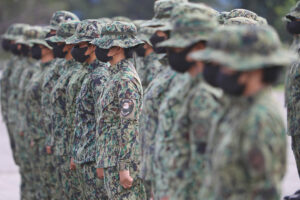By Kenneth Christiane L. Basilio, Reporter
THE US would likely press the Philippines to allot at least 5% of its gross domestic product (GDP) on military spending, defense analysts said at the weekend, after Washington called on its Asian allies to raise defense spending on par with standards set by a military grouping of western countries.
But economists warned that the Southeast Asian nation is unlikely to meet the spending target due to budgetary constraints and competing domestic priorities.
“The US has stated that the new North Atlantic Treaty Organization (NATO) standard should set a ‘global benchmark’ for allied defense spending, explicitly referencing Asian allies in recent statements,” Rocio Salle Gatdula, a defense economist currently taking up security studies at Georgetown University, said in a Facebook Messenger chat.
The Pentagon has called on Washington’s allies in Asia to raise defense spending to 5% of GDP in late June, following the push by US President Donald J. Trump’s administration to boost self-reliance of allies, as it emphasizes the need to share the economic burden of military expenses with its regional partners.
NATO leaders last month committed to hiking defense spending to the 5% benchmark by 2035, following Mr. Trump’s demands for increased collective military expenditure.
“Currently, a 5% target is not economically feasible,” said Ms. Gatdula, noting that Manila has spent only 1.25% of its GDP on military spending in 2023. “[This is] well below even the 2% spending level recommended by security experts.”
With the country’s 2025 nominal GDP estimated at $497.5 billion (P27.9 trillion), based on International Monetary Fund data, aligning with the 5% defense spending would mean military funding of at least $24.9 billion (P1.4 trillion).
But Washington should weigh its existing defense arrangements with Manila before pressing it to commit at least 5% of GDP to military spending, Julio S. Amador III, chief executive officer at Manila-based geopolitical risk firm Amador Research Services, said in a Viber message.
The Philippines’ hosting of US bases should be factored in the cost-sharing pursuit, he added, given its strategic importance in Washington’s Indo-Pacific posture amid rising regional tensions.
“There is a cost for the Philippines in hosting US forces and that should be considered,” Mr. Amador said.
President Ferdinand R. Marcos, Jr. in 2023 gave the US access to four more military bases under the Enhanced Defense Cooperation Agreement. These were on top of the five bases that US troops already had access to since 2016.
Meeting the US call for increased defense spending could force the Philippines to raise new taxes, take on additional debt or cut funding for other domestic priorities, Reinielle Matt M. Erece, an economist at Oikonomia Advisory and Research, Inc., said in a Viber message.
The government should look at improving its tax collection if it wants to achieve the 5% benchmark, Jonathan L. Ravelas, senior adviser at professional service firm Reyes Tacandong & Co., said in a Viber message.
Manila should also consider tapping public-private partnerships to expand its defense spending capacity, he added, as a way to ease budget pressures tied to meeting the US call for a hike in military funding.
Ms. Gatdula added that the government could pursue multilateral defense funds or partnerships as additional sources.
Mr. Amador, however, raised limitations under the 1987 Constitution, which provided that the education sector should receive the lion’s share of the national budget.
“Any demand for increase in defense spending on our part should take into account that we have a constitutional limitation that no other spending should be higher than education,” Mr. Amador said.
NAVY AND AIR FORCEThe government should pursue modernizing its navy and air force amid Washington’s call for increased defense spending, Ms. Gatdula said.
Key priorities include the purchase of multi-role fighter jets and advanced warships, including missile frigates and corvettes to exert a credible defense posture and expand the Southeast Asian nation’s presence in the South China Sea, she added.
Mr. Amador said the Philippines should also look at boosting its cyber-defense and anti-missile systems, while shoring up its “asymmetric” defense capabilities.
The Philippines has launched a $35-billion (P2 trillion) military modernization program to bolster its defense capabilities in the next decade, including the acquisition of advanced naval ships, planes and missile systems, as it pushes back against Chinese military might in the region.
“The trajectory of Manila’s defense spending is increasing mainly due to its active role in achieving a modernized military, pursuing a self-reliant defense posture and trying to build a national defense industry,” Chester B. Cabalza, founding president of Manila-based think tank International Development and Security Cooperation, said in a Facebook chat.
“It needs to catch up and upgrade the army, navy, and air force arsenals to safeguard the longest coastline in Asia,” he added.
The South China Sea has emerged as a major flashpoint, as Beijing continues to assert sweeping claims over the waterway using a U-shaped map from the 1940s, a claim that encroaches on the exclusive economic zones of the Philippines and several Southeast Asian nations.
A United Nations-backed tribunal in 2016 voided China’s expansive claims for being illegal, a ruling that Beijing does not recognize.
China would likely protest should Manila move to increase its defense expenditure, said Mr. Amador. “But that should not stop the Philippines and its strategic partners from protecting their national interests, including even modest spending.”
“Beijing would likely view a significant Philippine defense buildup, especially if it includes advanced maritime, air, and surveillance capability, as a direct response to its assertive actions in the South China Sea,” Ms. Gatdula said, adding that it could lead to increased Chinese presence in contested reefs and atolls in the waterway.

